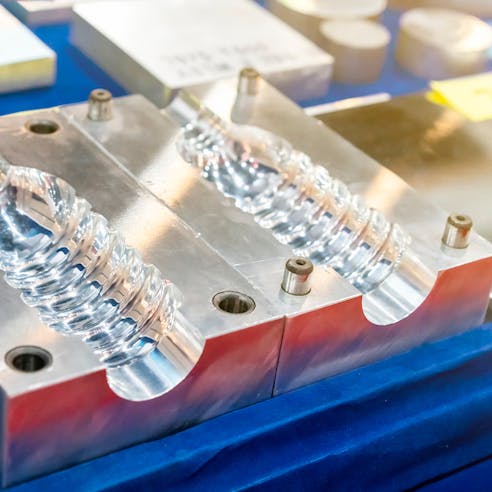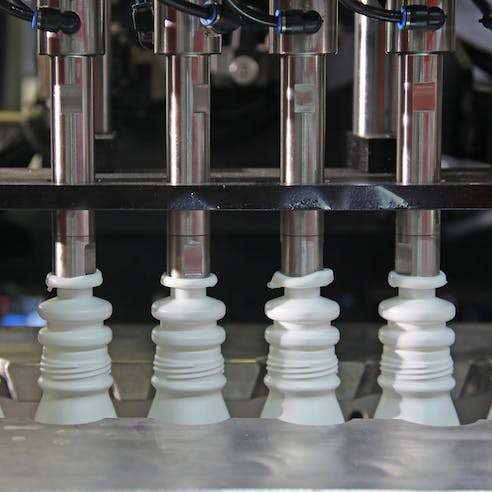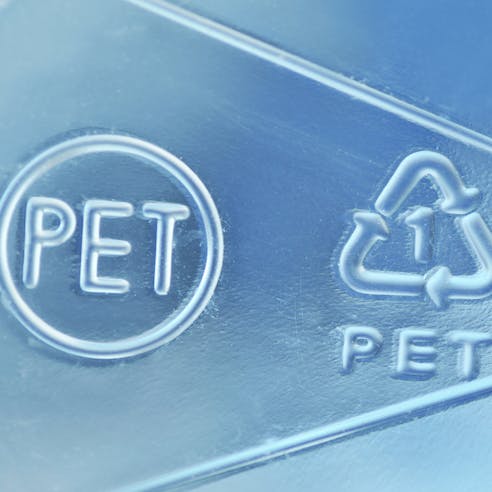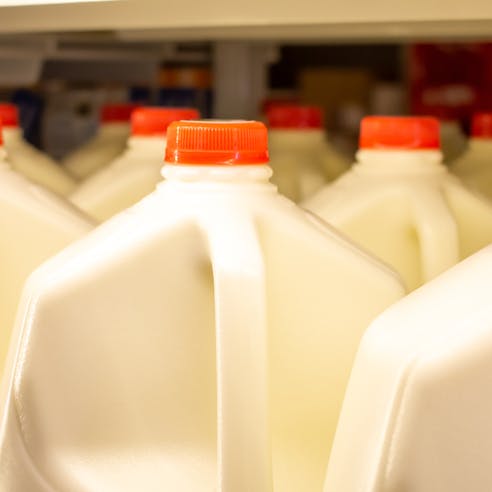Custom Blow Molding Services at Xometry
Xometry offers the highest quality custom blow molding services and can assist in the production of parts with intricate and complex geometries and excellent surface finishes. Subject to availability. Xometry doesn't guarantee that we can provide this service at any given time.
Blow molding is a high-volume plastics manufacturing method used to form hollow plastic products. The process involves inflating an extruded plastic tube to form the shape of a mold. Virtually any thermoplastic or thermoset polymer can be blow molded. However, HDPE (high-density polyethylene) tends to be the most commonly used material for this process. There are three primary forms of blow molding: injection blow molding and extrusion blow molding. The two (or three) subtypes differ, but share the advantages of all methods of blow molding: the ability to fabricate parts with complex geometries, fast production rates, and low tooling costs.
Xometry offers superior-quality custom blow molding services for a wide range of industries — from food, beverage, and consumer containers to automotive and waste collection products. With Xometry, you are guaranteed precision, high-quality components with short lead times, and matchless customer service.
What Is Blow Molding?
Blow molding is a plastic fabrication process in which a polymer tube is heated and inflated to form hollow plastic products. The process starts with heating the raw material and forming a closed-end tube known as a parison or preform. Then, two halves of a mold close around the parison. Next, pressurized air is injected into the tube, which inflates it and forces it to conform to the shape of the mold. The product then cools, is ejected from the machine, and the rough plastic where the air was initially injected is trimmed off. Blow molding is often used for fabricating large volumes of plastic parts with thin walls such as bottles, containers, fuel tanks, and protective consumer product casings.
Types of Blow Molding
Xometry offers blow molding services using all types of blow molding. There are three main forms of blow molding which are described in more detail below:
- Injection Blow Molding
- Extrusion Blow Molding
- Stretch Blow Molding

Injection Blow Molding
Injection blow molding combines traditional injection molding with blow molding. In injection blow molding, the preform or parison is made by injecting molten plastic onto a metal rod in a mold. This creates the preform. Then, the preform and metal rod are transferred to another mold that has the shape of the final product. Compressed air is then injected into the preform which then takes on the mold’s shape.
Injection blow molding is used to form products such as: beverage and shampoo bottles, consumer product casings, storage tanks, and containers. It offers higher precision than extrusion blow molding at the neck of the product where compressed air is injected. The preform is more tightly controlled than in the extrusion blow molding process since the preform mold is fabricated from a highly precise machining process. The most common materials used for injection blow molding include: HDPE (high-density polyethylene), PET (polyethylene terephthalate), PP (polypropylene), and nylon.
Extrusion Blow Molding
Extrusion blow molding entails extruding the hollow preform to a predetermined length. Like a balloon, the preform is sealed at one end while the opposite end is filled with compressed air. The preform is trimmed and then inflated to fill out the contours of the mold. After the molding process is complete, the new plastic part is cooled and ejected from the mold. The main difference between extrusion blow molding and injection blow molding is that the preform is extruded in extrusion blow molding. In injection blow molding, however, the preform is formed onto a core rod and transferred over to the blow molding machine in two separate processes. While minimal post-processing is required after ejection from the mold, extrusion blow molding produces more flash that must be trimmed compared to injection blow molding since its preform is not as precisely made.
Extrusion blow molding can be further subdivided into: continuous extrusion blow molding and intermittent extrusion blow molding. In continuous extrusion blow molding, parisons are continuously extruded, trimmed, and inflated with a little stoppage in between processes. Intermittent extrusion blow molding is similar to injection blow molding and involves the accumulation of homogenized molten plastic in the extruder barrel. When enough volume of homogenized material is obtained, it is extruded to form the parison and inflated to form the final product.
Extrusion blow molding is often used to form the same products as injection blow molding, including: water and beverage bottles, shampoo bottles, gardening watering pots, and automotive parts like mudguards and fluid reservoirs. Common materials for extrusion blow molding include: HDPE, PP, and nylon.
Stretch Blow Molding
Stretch blow molding, or injection stretch blow molding, can be thought of as a type of injection blow molding. Like injection blow molding, the preform is formed separately by an injection process. Then, the fabricated preform is transferred to a separate mold to form the final product. However, unlike injection blow molding, the preform is stretched and expanded to a predetermined dimension by a rod. After stretching, the preform is inflated to form the final shape of the product. Stretching helps improve the mechanical strength of the final product. This can be completed as a one-stage or two-stage process.
Stretch blow molding uses the same materials as injection blow molding and extrusion blow molding. Materials for stretch blow molding include: HDPE, PP, ABS (acrylonitrile butadiene styrene), and nylon.
Advantages of Custom Blow Molding
There are several advantages to making use of Xometry’s custom blow molding services. These include:
- Large Production Volume
- Complex Part Geometry
- Low Tooling Costs

- Large Production Volume: Blow molding is used to create large volumes of parts at a rapid pace. It is a largely automated process and requires little operator intervention. Additionally, fewer processes are needed to convert raw material (plastic pellets) to the finished product compared to other manufacturing methods like traditional injection molding which may require multiple processes and assembly to obtain hollow parts.
- Complex Part Geometry: Blow molding can easily make parts with complex geometries that could not be made using traditional injection molding or extrusion. Regular injection molding cannot make hollow parts like containers and bottles in a single process due to undercuts in the tooling that prevent product ejection. Hollow products can be made easily and in large volumes with custom blow molding.
- Low Tooling Costs: Blow molding, especially extrusion blow molding, has low tooling costs due to the lower pressures that are used to form products compared to traditional injection molding. Manufacturers can find value in blow molding for both small and large-scale production because of its relatively low cost compared to traditional injection molding which may require multiple injection processes and assembly to make hollow parts.
Common Blow Molding Materials
While any thermoplastic material can be blow-molded, high-density polyethylene (HDPE) is the most commonly used material. Thermosets are not typically used for blow molding since they become more rigid at high temperatures and thus do not expand in the same way as thermoplastics. Listed below are some materials often used for the process:
- HDPE
- PET
- ABS
- Nylon

- HDPE: HDPE is the most frequently used material for blow molding due to its low processing temperatures, chemical resistance, and high strength-to-weight ratio. HDPE is commonly used for food and beverage containers.
- PET: PET (polyethylene terephthalate), like HDPE, is often used in blow molding due to its: relatively low cost, low processing temperature, chemical resistance, and high strength-to-weight ratio. PET is frequently used for clear food, beverage, and storage containers.
- ABS: ABS (acrylonitrile butadiene styrene) is another commonly used material for blow molding because of its high strength and relatively low cost. However, it is not as chemically resistant as HDPE and PET. ABS is often used for common household products like bottles for household cleaners, electronic housings, and small appliances.
- Nylon: Nylon is frequently used in blow molding due to its ability to be used at high temperatures and its chemical resistance. Because of these traits, Nylon blow-molded products are typically used in the automotive industry for fluid reservoirs.
In need of custom blow molding services?
Common Blow-Molded Products
Many everyday products are made by one of the blow molding processes. Some products commonly made by blow molding are listed below:
- Plastic bottles
- Milk jugs
- Food packaging containers
- Automotive duct work
- Automotive fluid reservoirs
- Garbage bins
- Beverage coolers

Industries Which Use Blow-Molded Products
Several industries use blow molding to fabricate large amounts of complex parts with tight tolerances. These industries are listed below:
- Food and Beverage
- Pharmaceuticals
- Automotive
- Cosmetics
- Waste Collection

- Food and Beverage: The food and beverage industry is perhaps the biggest user of blow-molded products. Soda and water bottles, as well as milk jugs and food containers, are all made by blow molding.
- Pharmaceuticals: Pharmaceuticals come in pill bottles that are commonly made by blow molding.
- Automotive: Automotive components such as: fluid reservoirs, mudguards, and air ducts, as well as motor oil and other automotive fluid bottles.
- Cosmetics: Cosmetics is another industry that frequently uses blow-molded products. Shampoo bottles and lotion bottles, as well as consumer product casings for various cosmetic products, are commonly made by blow molding.
- Waste Collection: Plastic garbage bins, storage containers, barrels, and more can be made by blow molding.
Why Choose Xometry for Custom Blow Molding Services?

Endless Options
Choose from millions of possible combinations of materials, finishes, tolerances, markings, and certifications for your order.

Easy to Use
Get started with our easy-to-use platform and let our experts take care of managing the project from locating the right manufacturing partner to delivery logistics.

Vetted Network
We are ISO 9001:2015, ISO 13485, and AS9100D certified. Only the top shops that apply to become Suppliers make it through our qualification process.